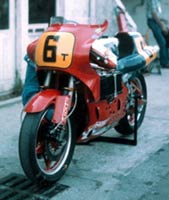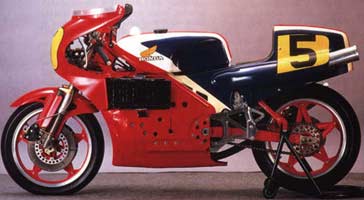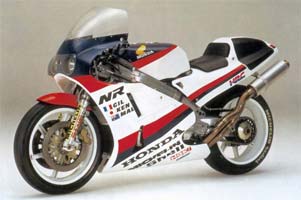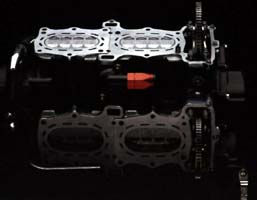| Author | Message | ||
Djkaplan |
"What does a 2 stroke 500 gp bike have to do with a 4 stroke 750 street bike?????? Dosent mater if its the early 80's NS or late 80's early 90's NSR??? " My fault. I dropped the wrong letter from NSR..., I meant NR500, the one from the late 70's. But, come on, you knew that too! Didn't you? Honda campaigned the oval piston 4-stroke V-4 in the late 70's in the 500 GP. It didn't have the luxury of today's 990cc limit and didn't fare very well against the 2-strokes. A rare disappointment for Honda, but not really a failure. I remember talk of stratospheric redlines of 22,000 rpm with this bike. Odd, there isn't one google image of the GP bike, only the later endurance racers. | ||
Eeeeek |
This is amazing. You have legions of people basing their positive opinions of the ZTL off what they experience when they ride and when I comment the same thing about a non ZTL system, I'm the ignorant one? I can't debate you if you keep shifting the rules. Congratulations, you have chased me off. Vik | ||
M1combat |
Vik... Most of us are arguing that there are tradeoffs. You mostly are arguing that the conventional system is "better" or that the ZTL is "inferior" due to the way they have felt in your experience. You really didn't set the suspension of that XB to your weight? After the warnings about how sensitive it is to setup and tire pressure? Then you come back and say "It don't work so good"? Hengh? Are you talking about the one you had the chance to ride at the track or the one you demo'd? WRT the ignorance... I assume you were responding to this... "Refusing to recognize the very real and significant benefits of carving multiple pounds of unsprung mass from the front wheel/brake system of a motorcycle is not objective. It is ignorant. " Well... It is if you ask me. Maybe you can tell me why that's not the case. What are the benefits of having "enough" braking power (both systems have "enough"  and MORE unsprung mass? Give me your analysis of the strengths of the conventional setup. Please leave the ZTL out of it for now, just give me the technical merits that the conventional setup provides. Please explain this to me. Thanks in advance. and MORE unsprung mass? Give me your analysis of the strengths of the conventional setup. Please leave the ZTL out of it for now, just give me the technical merits that the conventional setup provides. Please explain this to me. Thanks in advance. | ||
Fdl3 |
Talk about being different... It seems that in the sportbike market (and others, too), anything born out of the rigors of racing and passed on to street duty is a very good thing.  Afterall, something that can take the stress and strain on the track is surely more than acceptable for the street. If something is proven on the track to be good, it surely is good for the street. I am not saying this is right, just an observation on my part. Afterall, something that can take the stress and strain on the track is surely more than acceptable for the street. If something is proven on the track to be good, it surely is good for the street. I am not saying this is right, just an observation on my part.  The current dual-rotor, radial-caliper brake systems on today's sportbikes have proven themselves first in a racing application. This setup has passed the rigors of racing, and is surely more than adequate for street duty. Whether this system is "overkill" for the street is arguable, but it sure is nice to have and to know that the racing heritage has proven it to be more than up to the task of braking. Afterall, past performance cannot be denied. Enter the ZTL brake system  . Here we have a "new" and "different" brake system that has taken good ideas from the racing arena (e.g. lower unsprung mass...gooood; lighter front wheel...gooood; larger brake rotor surface area...gooood) to produce a STREET product FIRST without being born out of a RACING application (this might be an arguable point, but bear with me...it's my post . Here we have a "new" and "different" brake system that has taken good ideas from the racing arena (e.g. lower unsprung mass...gooood; lighter front wheel...gooood; larger brake rotor surface area...gooood) to produce a STREET product FIRST without being born out of a RACING application (this might be an arguable point, but bear with me...it's my post  ). It seems backward from the way things are currently done in the sportbike market. It's not as proven. ). It seems backward from the way things are currently done in the sportbike market. It's not as proven. Now, these may be over-generalizations on my part  , but here is the point I am trying to make: the market says that street products (or "systems" , but here is the point I am trying to make: the market says that street products (or "systems" born out of racing are good and acceptable; of course, the converse is that street products (or "systems" born out of racing are good and acceptable; of course, the converse is that street products (or "systems" not born first out of racing are (or must be) bad. Right or wrong (or even somewhere in the middle not born first out of racing are (or must be) bad. Right or wrong (or even somewhere in the middle  ), some people will adhere to this tenet to prove the worth (or worthlessness) of some product (or "system" ), some people will adhere to this tenet to prove the worth (or worthlessness) of some product (or "system" . . Someone who holds to the above tenet will feel that Buell is too different. Buell is so kicking against the goads of current market trends, that some people just don't like it. It's new. It's untried. It's unsafe. Buell is just using a marketing gimmick to make their product look better. The ZTL brake system can't possibly work as well as current brake systems because: a) the ZTL itself was not born out of racing (just some tried-and-true IDEAS); b) the ZTL has not been proven enough on the track. And when the ZTL in its current incarnation IS used on the track, it seemingly doesn't offer the same level of braking performance as the current brake systems. An arguable point?  Certainly, especially if you conveniently discount any future iterations of the ZTL. Certainly, especially if you conveniently discount any future iterations of the ZTL. But for the here-and-now, racers are going to stick with tried-and-true systems until such a time (if ever) a new system can demonstrate it's worth over an existing tried-and-true system. Period. So we can debate  all day long the technical merits of the ZTL, and the tradeoffs and advantages of it versus other braking systems. Some will be offended if the ZTL is heralded; some will be offended if the ZTL is dogged. all day long the technical merits of the ZTL, and the tradeoffs and advantages of it versus other braking systems. Some will be offended if the ZTL is heralded; some will be offended if the ZTL is dogged.  So what's the "answer"? Beats me!  If nothing else I have been able to get this off my chest and practice putting smilies in my post! If nothing else I have been able to get this off my chest and practice putting smilies in my post!  | ||
Djkaplan |
"larger brake rotor surface area...gooood)" As I stated in an earlier post, I don't think this is true at all. I did some simple area calculations and don't see how this could be true, even when compared to 300mm rotors. Why do you think this is true? | ||
Fdl3 |
Djkaplan: For heat dissipation, not necessarily for braking performance, per se. To help reduce brake fade?  | ||
Djkaplan |
That doesn't explain why you think the ZTL rotor has more surface area than two 300mm rotors, but I won't quibble. | ||
Fdl3 |
Djkaplan: Oh, I have no idea if the single ZTL rotor has more surface area than two 300mm rotors. I would doubt it. I was under the impression that a ZTL rotor has more surface area than a standard single rotor. My real point for bringing up the idea of rotor surface area being a good thing is that the more surface area, the better at reducing brake fade. | ||
M1combat |
You have a point there, and the braking performance on the track is certainly "somewhat" up in the air (although it "seems" to work just fine... I don't recall any FX Buells running off into the trees because their brakes quit working). The question is about the trade off. Does the ZTL brake system brake well enough that it makes the road holding benefits worth it? On the street that's a resounding YES! On the track, it depends on the smoothness of the track I think. The thing is... As long as you aren't losing MUCH under braking, it makes sense there too. | ||
Fdl3 |
Could the radical geometry of the XB platform be limiting the ZTL brake performance? What if the real issue is not so much the braking power of the ZTL system, but that the ZTL system cannot be fully utilized because of said geometry? I wonder if there is a difference in braking performance/feel with the new long versions of the XB platform? What if Buell were to make a Long Firebolt, with dual ZTL rotors?  And would it be better such that I would be prompted to buy one? Questions, so many questions... | ||
M1combat |
"Could the radical geometry of the XB platform be limiting the ZTL brake performance? What if the real issue is not so much the braking power of the ZTL system, but that the ZTL system cannot be fully utilized because of said geometry? " Uhh, yes. That's EXACTLY the issue. Once you have a small enough rake that you generate a large enough normal force to attain the traction needed to be able to lift the CG then you CAN'T use any more power (unless you like face plants of course). Brake distance is more a function of geometry than braking torque provided you have enough traction and torque to lift the CG. So the question is... Does the advantage that the geometry and unsprung mass affords out weight the longer brake distance? Again... "On the street that's a resounding YES! On the track, it depends on the smoothness of the track I think. The thing is... As long as you aren't losing MUCH under braking, it makes sense there too." | ||
Fdl3 |
Hmm. That question certainly becomes harder for me to answer for myself now. I have to admit, I have not ridden the very latest Japanese sportbikes, but I fathom they handle extremely well. I mean, they are designed to be nimble, right? And older model Japanese sportbikes seemed nimble at the time, but I am sure not to the same standard as today's sportbikes. Can one notice a big handling difference between a Japanese sportbike and a Buell XB9R/XB12R on the street? | ||
M1combat |
Depends on the situation I think. That said, I haven't ridden any of the modern IL4 sport bikes but I've followed quite a few through The Spars and when the road gets bumpy they have to modify their line to avoid the bumps. I don't. One place in particular is a down hill tightening radius right hander that dumps you into a 30' straight then a 90 left into a 25-30 yard straight. Speed through the right hander is about 50 or so, it's posted 25. The IL4's that I've followed that looked like they both knew the road and were trying to stay on our side of the road would swing to the outside of the lane of the right hander to avoid the bumps that are on the right side. That absolutely murders their ability to flop into the 90 left and get a good drive onto the straight if they choose to stay in the right lane. The ones that don't look like they know the road real well... their front wont stick to the road at the inside, so they end up moving to the outside of our lane anyway but at the wrong angle so they still murder their ability to get on the gas through the 90 left. The reduction of unsprung mass is directly responsible for that IMO. The brakes are plenty good for at least 22 miles of "fairly hard" riding on the street. Hard enough that the rear lifts while approaching turns. I usually leave myself plenty of room so I can release the brakes well before I roll in though, but sometimes I make a run where I use the brakes pretty hard. I also weigh 220Lbs too... They've never faded on me on the street. So, the trade off seems exceedingly worth it to me on the street, and I don't really recall ever seeing a Buell in FX having any significant braking issues (with non-stock brakes of course). WRT to the modern Japanese bikes handling "extremely well"... Take a look at Bike magazine's "top 50 cornering bikes" article. Do a search here on the BadWeb and you'll find a link to the PDF. Pay particular attention to the "remove the emotion" portion. The XB12R placed second to the Ducati 999R. The only category it lost out in was "drive out of the corner". I wonder how much more drive can be bought with the $20K price difference? "Enough" me thinks. For the record if you don't find the article, the XB12R placed first in the portion of the article "with emotion". Second and third were a 650 Triumph and Aprilia's RS-250... It's a good article and worth the read  . . | ||
M1combat |
"they are designed to be nimble, right?" Not specifically... They are designed to be a good balance between nimble and stable at high speeds. The XB is designed to be nimble AND stable at high speeds. The placement of the rotor and the large flywheels help to make this possible. | ||
Blake |
Vic, Who said that you are ignorant?  | ||
M1combat |
"Refusing to recognize the very real and significant benefits of carving multiple pounds of unsprung mass from the front wheel/brake system of a motorcycle is not objective. It is ignorant. " He may have been referring to that quote from you, but that would require the stretch that he does indeed refuse to recognize that there are significant benefits to a sizable reduction of unsprung mass... Maybe it was something else? | ||
Jon |
I'm just catching up on the posts...been working too much. | ||
Blake |
Be warned, you'll apparently need to wade through the opinions of "legions of people."  | ||
Xb12rene |
For DJ here are some pics of the Hondas first the NR500   the endurance racer  and a picture of the pistons of the NR750 roadbike  Rene | ||
Jon |
Vik's a good egg. After he cools off, I'm sure he will be back to clarify. | ||
Reepicheep |
Thanks for showing the pistons, never saw those before. Why on earth did they point them that direction? They should be front to back, with an oversquare engine and a big V you could then have a very cool narrow but powerful package. As it is, the thing looks wide as a truck... | ||
Grndskpr |
Why on earth did they point them that direction? because each piston had 2 rods R | ||
Blake |
I like Vic.  | ||
Fdl3 |
...maybe they have poorly adjusted suspensions. Speaking of suspension settings, if I may ask: a) what is your riding weight; b) what are your suspension settings? | ||
Blake |
M1 sometimes partakes of the Kool-Aid straight up, in large quantity, and double strong.  But this is a Buell Enthusiasts' forum, so we let it go. His enthusiasm is much appreciated.  Just don't OD there M1. Just don't OD there M1.  | ||
Wyckedflesh |
Having ridden an XB with a ZTL and a ZX6RR with the dual radial caliper set up, back to back, I found, again, ME, I, Myself, found the lack of feel of the dual rotors not very confidence inspiring as well as the fact they were a 3 finger brake system. Either one could vault you over the front with too much lever. I feel the comment of the geometry is a limiting factor when you compare straight out braking distances is accurate, and I do not think in the case of the XB, that either the ZTL NOR the Dual Rotor system will make much difference IF they were the only changes. It has however been my experience/observation that when someone converts an XB/ZTL front brake to a dual rotor setup there are also fork changes that very well could also be a point of improvement over the ZTL by itself. An honest and interesting test of the ZTL would be to make a level playing field. Take the Dual Rotor FACTORY system from a comparabale performance class bike. For example, take the ZTL and forks, mount them on say a ZX6RR and vice versa. Observe the braking distances and handling characteristics and how they change between both bikes. Make no other changes to either geometry, fork adjustment quality nor change springwieghts except to make them comparable/equal. Lighten the springweight of the XB forks to match the springweight from the factory of the ZX and up the springweight of the ZX to match the XB when mounted on each bike. THAT would give you a fair analysis of whether the ZTL system is a worthwhile track system or if it is only a worthwhile street system. Everything else is basically supposition with out anything empirical to compare apples to apples and oranges to oranges. Hey Vik, just out of curious, I do have a spare set of XB forks laying around with a spare caliper. Maybe if someone offered the loan of a front wheel, how about we put a ZTL on your SV, and get your opinion then?(note my forks do have 18000 miles on them and do need to have the fork oil changed again, but I do have a fresh unopened bottle of Maxxus 7w racing fork oil on the bench...) | ||
Reepicheep |
Very cool idea Wycked. An SV with an XB front end would actually be a very cool bike! | ||
M1combat |
Oh come on... Thats a true satement  . . I do drink from the punch bowl on occasion but it makes a ton of sense on the roads I like to ride and I've really followed a great deal of modernish sportbikes through the Spars. That happpens when you put about 8K miles on a bike over an 11 mile section of road that has more than 150 turns  . Yes, my driveway is curvey too . Yes, my driveway is curvey too  and it dumps me right out at the beginning of the Spars. About 20' in front of the first turn actually and it dumps me right out at the beginning of the Spars. About 20' in front of the first turn actually  . The XB works well on that road. . The XB works well on that road. I may do a trackday on the sixth but I'll need to ride 100 miles each way. I don't really want to bin my favorite form of transpo either... Good call Mikel... I wish I had an extra wheel. | ||
Johnb |
so theoretically, if buell engineers were to dream up a better performance solution to the perceived racing inadequacies of the stock ZTL system - are you guys perhaps pointing to maybe considering a slightly BIGGER rotor, caliper, and pistons? (just dreaming of the new firebolt)  | ||
Wyckedflesh |
Don, you do have to admit, you DO have an unfair advantage over your average rider in the Spars. 'Track Knowledge' in this case road knowledge does lend you a hefty advantage. The real test would be for you to get familiar with another bike, and then ride it in comparison to the XB back to back over that stretch of road. |